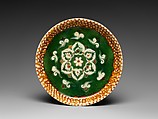Tray
Not on view
Combinations of white, amber, and green glazes, typically known as sancai or “three-colored” wares, were first developed in China in the late seventh century, and were used primarily for funerary goods. The bright colors, clear tones, and superior bonding power of this technique were achieved by firing twice, first at high temperature to achieve a hard pottery body, and then at low temperature, after the glazes were applied, to bring out the vibrant colors. The shape and medallion decor of this tray were derived from metalwork prototypes. The deep, intaglio lines of the floral patterns, impressed onto the surface of the still-soft clay by stamps, helped to contain the glaze in the intended areas. The pearl-like white spots on the rim were created by the use of wax or clay resists, a technique commonly employed in dyed textiles.
Due to rights restrictions, this image cannot be enlarged, viewed at full screen, or downloaded.
This artwork is meant to be viewed from right to left. Scroll left to view more.



